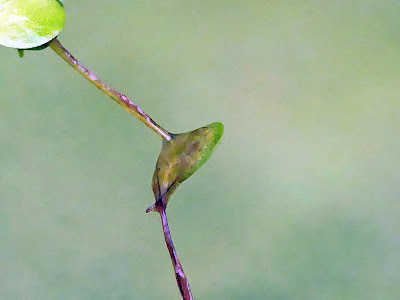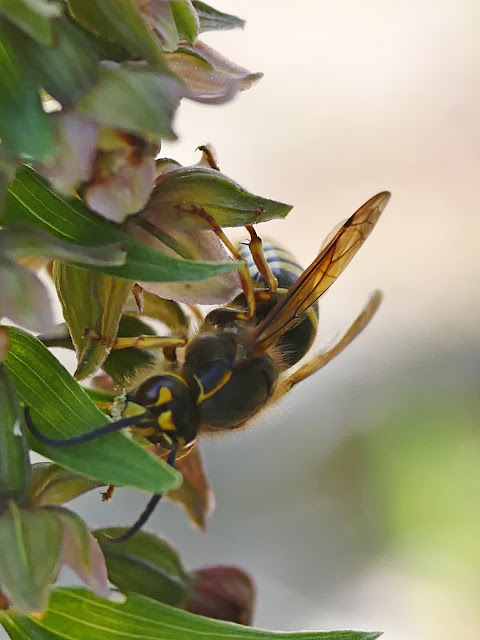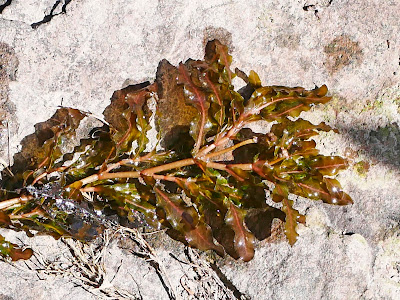The heatwave forecast for the end of July didn't materialise and the weather has been cool with occasional showers and plenty of drizzle. The amount of rainfall hasn't been much, but it's been enough to keep the wild plants going after the extremely hot weather of the first half of the month. Here's my highlights from various venues to end the month with.
I took a trip to a boggy heathland near Bodmin, searching for Bog Orchids. They were recorded here in 1993 when 27 spikes appeared there. They'd never been seen there before that and they have failed to appear since. However, that didn't stop me looking for them. Although I didn't find them, I photographed a few species also found there, like the lovely Wavy-leaved St. John's-wort. This has scarlet stripes to the underside of its petals, and as the name suggests, wavy edged leaves.
Hypericum undulatum
The Spring catkins of Bog Myrtle had turned into fruits, like elongated spiky mini pineapples on a bush. All parts of this plant smell lovely, yet the environment it lives in smells of rank, rotting anaerobic bog! If you find this species, be careful. It means you have wandered into a habitat that can be treachorously boggy and you could sink deeply into it. It's typically in Molinia mire, which is comprised of huge tussocks of Purple Moor Grass with the leaves covering up deep channels in the bog that you can (and will) step into inadvertantly and cause you to get a boot stuck, fall over or worse, break a bone in your leg. I've got to the age now where I will avoid such habitats as I don't think I'd have the endurance to get out of them anymore.
Myrica gale
In the drier parts of the area were drifts of White Beak Sedge, looking like a sea of stars twinkling in the evening sunlight.
Rhynchospora alba
In a totally different habitat, this time by the sea, were stands of Round-leaved Mint. It's fairly easy to identify and has a musky mint scent. The flower spikes look similar to Spearmint; however, that has a different smell, just like the gum and the leaves are lanceolate not rounded. There is a hybrid between them too which looks like Round-leaved Mint, but the leaf teeth point straight out, giving the leaves a nettle like appearance. In Round-leaved Mint, the teeth are curled down and under the leaf making the leaves look rounder than they really are.
Mentha suaveolens
At the end of the month, I ventured to the northern edge of Cornwall and recorded a village near Morwenstow, called Shop. It hadn't been recorded for several years, so was worth a visit. In one field corner, I found a clump of Nettle-leaved Goosefoot. It's a distinctive species as you can see. It seems to unexpectedly turn up anywhere there is soil disturbance. The last time I found some was after a retail park was extended in Bodmin and the plant came up on fresh soil to the side of it. These below, were not yet in flower, but the flowers lack any petals anyway and look like a bunch of green hairy blobs up a stem. Unless you looked at them microscopically, the flowers aren't of use in identifying Goosefoot species.
Chenopodiastrum murale
Along a rural country lane, I found a small colony of Wild Basil, in the same genus as Common Calamint, but it has a completely different look to it. I used to associate it as a chalk plant, but it was doing well on the mildly acidic soils found here. On checking Cornwall records for it, I found that it is frequently recorded throughout Cornwall, though this is the first time I've found any in the 5 years I've been living here.
Clinopodium vulgare
It's not always just about the flowers. If an insect obliges me by staying relatively still, I'll take a photo, but my days of following them around hoping they'll stay still for me are now gone. Here's what I believe is a Common Carder Bee on a Common Knapweed flower.
Bombus pascuorum
It's tempting to only include rare or unusual wildflowers in the blog, but sometimes the common, everyday species are just as interesting. Here's a Great Willowherb in flower, with a darker purple flower than usual. Beautiful.
Epilobium hirsutum
One of the commonest St. John's-worts in Cornwall, is the Square-stalked, often found in woodland rides, though I recently saw lots of it growing around a building site right in the centre of Bodmin! As the name suggests, the stem appears to be square, though in reality it has 4 raised ridges making it feel square. The inflorescence is usually a tight cluster of smaller flowers at the top of the stem. The one below has started to turn a lovely red colour, though to the plant, that probably means it is stressed. In this case, probably due to lack of rain.
Hypericum tetrapterum
A solitary Ragged Robin on a woodland path where it was a bit damper.
Silene flos-cuculi
One of the last common road verge umbellifers to flower is Upright Hedge Parsley, characterised by its slim, pointy parsley leaves and small heads of pink or white flowers.
Torilis japonica
Whilst there were still lots of Tufted Vetch flowering, I thought it would be interesting to see the pods for a change. They hang down just like the flowers did before them.
Vicia cracca
Zig Zag Clover is more common in the North East of Cornwall than the rest of the county, and I found a few colonies on road verges. The leaves are unmarked, longer and thinner than Red Clover; the stipules are a long lanceolate shape ending in a sharp point and lack the elliptical part with veins that Red Clover has, and; there are no subtending leaves directly under the flowers.
Finally, some views from this trip. Always look for a variety of different habitats to find the largest number of plant species. Find a walk that includes woodlands; streams, ponds, bogs; scrub; urban and brownfield; arable field edges and corners and you will find a huge variety of species.
That rounds off July, I hope you enjoyed my selection of plants. Until next time.
Regards
Dave

















































































